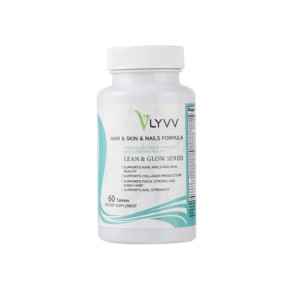Healthy Aging What Happens to Our Bodies Over Time !
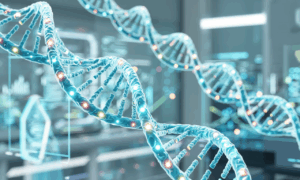
Aging is a natural part of life. It’s something we all experience, but it’s also something that many people don’t fully understand. We may associate aging with growing older, getting wrinkles, or developing health problems, but the truth is that aging is a complex biological process that affects every cell and system in our body. In this article, we’ll explore the science of aging, what happens to our bodies as we age, and how we can promote healthy aging to maintain a high quality of life as we grow older.
What is Aging?
Aging is a natural, inevitable part of life. It is the process by which our bodies undergo gradual changes over time that affect the function and structure of our cells, tissues, and organs. While we all experience aging in some form, the way our bodies age can vary from person to person, influenced by a combination of genetics, lifestyle choices, and environmental factors.
At the core of aging is cellular decline. Our bodies are made up of trillions of cells, and each of these cells is constantly working to keep us alive and healthy. As we age, however, our cells begin to lose their ability to repair and regenerate, which leads to functional decline in organs and tissues. Over time, this decline affects how well our bodies can perform the tasks they once did effortlessly.
There are several key processes that contribute to aging at the cellular and molecular levels. These processes can be grouped into genetic changes, damage accumulation, and dysfunctional repair mechanisms. Essentially, aging is the result of a combination of internal biological clocks (regulated by our genes) and external factors (such as environmental exposure, diet, and lifestyle).
From a broader perspective, aging is not just about getting older — it is a biological process that affects everything from the cells inside our bodies to the way we look, feel, and function on a daily basis. As we age, we become more vulnerable to a variety of age-related diseases such as cardiovascular disease, diabetes, and Alzheimer’s disease. In addition to the physical changes we experience — like wrinkles, gray hair, and a loss of muscle mass — our immune system and organ systems become less efficient, making us more susceptible to illness.
Despite the challenges that aging brings, it’s important to remember that healthy aging is possible. By understanding the science behind aging, we can take steps to slow down the process, promote better health, and reduce the risk of age-related diseases. This involves adopting a healthy lifestyle, managing stress, and staying physically and mentally active, among other things.
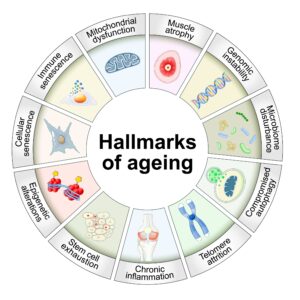 The Hallmarks of Aging
The Hallmarks of Aging
Aging is driven by various biological mechanisms, many of which have been identified as the “hallmarks of aging.” These hallmarks are the biological processes that underlie the aging process, affecting everything from our cells to our organs. Researchers have identified nine primary hallmarks of aging:
Over the years, scientists have identified a set of biological mechanisms that underlie the aging process. These mechanisms are commonly referred to as the “hallmarks of aging.” These hallmarks help explain why and how we age at the cellular and molecular levels. They represent the fundamental processes that lead to the progressive decline in the body’s ability to maintain health and function.
The concept of hallmarks of aging was introduced in a landmark paper by scientists in 2013. The aim was to outline the key biological factors that contribute to aging and provide a framework for understanding how aging happens at a deep biological level. These hallmarks, which involve both genetic and environmental factors, include:
- Genomic Instability
Genomic instability refers to the gradual accumulation of damage to our DNA over time. Our DNA is the blueprint for our entire body, and its stability is crucial for normal cellular function. However, throughout our lives, our DNA is constantly exposed to various sources of damage, such as UV radiation, environmental toxins, and even normal metabolic byproducts. Over time, this damage can lead to mutations, chromosomal aberrations, and reduced gene expression. The result is the gradual breakdown of cellular functions, leading to diseases like cancer and neurodegenerative disorders.
Genomic instability contributes to aging because damaged DNA causes mutations in key genes that help our cells survive and divide. These mutations accumulate over time, leading to a decrease in the function and efficiency of our cells. Our cells become less effective at repairing themselves, and over time, this damage spreads across our tissues and organs.
- Telomere Attrition
Telomeres are the protective caps located at the ends of our chromosomes. They play a crucial role in protecting our DNA during cell division. Every time a cell divides, its telomeres shorten slightly. This process is normal and happens as part of the cell cycle. However, as we age, the telomeres continue to shorten, and eventually, the cell can no longer divide properly, leading to cell death or senescence (where cells stop functioning properly).
The shortening of telomeres is often likened to the fraying of the ends of a shoelace — eventually, the shoelace becomes unusable, just as a cell with short telomeres cannot divide and regenerate. Telomere shortening is a natural part of aging, but it also plays a significant role in age-related diseases like heart disease, diabetes, and Alzheimer’s disease. As telomeres become too short, the body’s ability to repair tissues and regenerate organs declines, leading to physical frailty and disease.
- Epigenetic Alterations
Epigenetics refers to changes in gene expression that do not involve changes to the underlying DNA sequence. In other words, epigenetic changes affect how our genes are turned on or off, which can have a significant impact on our health. These changes can be caused by a variety of factors, including diet, stress, toxins, and aging itself.
As we age, our epigenetic patterns become disrupted. This means that our genes may no longer function as they should. For example, some genes that protect us from disease may be silenced, while others that promote aging may become more active. These changes are linked to chronic diseases, inflammation, and cognitive decline. Understanding and manipulating epigenetics may one day lead to therapies that slow or even reverse aging.
- Loss of Proteostasis
Proteins are the workhorses of our cells, carrying out nearly every essential function. Our cells have mechanisms in place to ensure that proteins are properly folded, maintained, and recycled. However, as we age, these processes become less efficient, leading to the accumulation of misfolded or damaged proteins. This disruption in protein homeostasis, or proteostasis, contributes to a variety of age-related diseases, including neurodegenerative diseases like Alzheimer’s and Parkinson’s disease.
Proteins are involved in virtually every cellular process, from metabolism to signal transduction. As our cells accumulate more damaged proteins over time, it becomes harder for them to function properly, leading to an overall decline in organ function.
- Deregulated Nutrient Sensing
As we age, our bodies become less responsive to the signals that control our metabolism. Nutrient sensing pathways, such as those controlled by insulin and mTOR (mechanistic target of rapamycin), are responsible for regulating growth, energy balance, and cellular maintenance. When these pathways become deregulated, it can lead to metabolic diseases, such as obesity, diabetes, and cardiovascular disease.
This deregulation occurs because the body’s ability to process and respond to nutrients like glucose and amino acids becomes less efficient with age. As a result, the body may not be able to maintain proper cellular function, leading to a higher risk of disease.
- Mitochondrial Dysfunction
Mitochondria are the powerhouses of our cells, responsible for producing the energy needed for cellular activities. Over time, mitochondrial function declines due to the accumulation of oxidative damage. This leads to a decrease in the cell’s ability to produce energy, which affects everything from muscle function to brain health.
Mitochondrial dysfunction contributes to a variety of age-related diseases, including neurodegenerative diseases and muscle weakness. Additionally, the accumulation of oxidative damage within mitochondria increases the levels of reactive oxygen species (ROS), which in turn cause further damage to cells and tissues.
- Cellular Senescence
Cellular senescence occurs when cells stop dividing and become damaged, but don’t die off. These senescent cells accumulate in tissues over time, leading to chronic inflammation and tissue dysfunction. While senescent cells are a natural part of aging, their accumulation contributes to age-related diseases, such as arthritis, atherosclerosis, and diabetes.
Senescent cells release harmful molecules that disrupt the surrounding tissue, leading to chronic inflammation. This contributes to the aging process and the development of diseases.
- Stem Cell Exhaustion
Stem cells are responsible for regenerating tissues and repairing damage. As we age, the number and function of stem cells decline, making it harder for the body to repair itself. This decline in stem cell activity is linked to aging in many organs, including the bone marrow, muscles, skin, and brain.
Stem cell exhaustion is a key factor in the loss of tissue regeneration and the decline of organ function with age. As stem cells become less efficient, the body struggles to repair damaged tissues, contributing to frailty and chronic diseases.
- Altered Intercellular Communication
As we age, the way our cells communicate with one another changes. This disruption in cellular communication leads to chronic inflammation and impaired tissue function. Inflammation is a common feature of aging, contributing to many of the diseases associated with old age, such as cardiovascular disease, Alzheimer’s disease, and diabetes.
Altered intercellular communication means that the signals between our immune cells, tissues, and organs become less efficient, making it harder for the body to repair and maintain itself.
Healthy aging goes beyond just the absence of disease; it is about maintaining a high quality of life as we age. Healthy aging is about staying physically active, mentally sharp, and emotionally well-balanced while avoiding or managing the effects of age-related diseases.
The goal of healthy aging is not to stop aging altogether — which is currently impossible — but to slow down the aging process and mitigate its negative effects. It involves taking steps to maintain physical and mental health, enhance quality of life, and reduce the risk of age-related diseases like heart disease, diabetes, dementia, and arthritis.
The key to healthy aging lies in lifestyle choices. People who take steps to lead a healthy lifestyle — such as eating a balanced diet, exercising regularly, and managing stress — tend to age better than those who do not.
The Role of Genetics in Aging
While lifestyle choices are crucial, genetics also play a significant role in the aging process. Our genes provide the blueprint for how our bodies function and influence how well we age. Some people are genetically predisposed to age more slowly and maintain better health into their later years, while others may be more susceptible to age-related diseases due to their genetic makeup.
Researchers have identified several genes that influence aging, such as FOXO3A, which is associated with longevity, and SIRT1, which regulates processes related to cellular repair. However, genes are not destiny. Environmental factors, such as diet and exercise, can “turn on” or “turn off” certain genes, influencing how we age.
Practical Advice for Healthy Aging
While aging is inevitable, there are many steps we can take to age more gracefully and enjoy a higher quality of life as we grow older. Here are some practical tips to help promote healthy aging:
√ Exercise Regularly: Physical activity is one of the best ways to promote healthy aging. It helps maintain a healthy weight, improves cardiovascular health, strengthens bones and muscles, and boosts mood and mental clarity. Aim for at least 150 minutes of moderate-intensity exercise per week.
√ Eat a Balanced Diet: Nutrition plays a huge role in how we age. Eating a diet rich in fruits, vegetables, whole grains, lean proteins, and healthy fats can help reduce inflammation, maintain brain function, and support overall health. Focus on antioxidants (e.g., berries, leafy greens) to fight oxidative stress, and include omega-3 fatty acids (e.g., fish, flaxseeds) to support heart and brain health.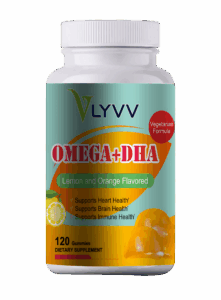
√ Get Enough Sleep: Sleep is essential for repair and recovery. As we age, our sleep patterns may change, but getting enough restful sleep is still crucial for maintaining health. Aim for 7-9 hours of sleep per night to support cognitive function, immune health, and overall vitality.
√ Manage Stress: Chronic stress can accelerate the aging process, so it’s important to find ways to manage stress effectively. Practices like meditation, yoga, and deep breathing can help reduce stress and promote relaxation.
√ Stay Mentally Active: Keeping your brain sharp is just as important as staying physically active. Engage in activities that challenge your mind, such as reading, puzzles, learning new skills, or even taking up a hobby like painting or playing a musical instrument.
√ Social Connections Matter: Having strong social relationships is linked to better mental and physical health as we age. Stay connected with family, friends, and community groups to combat loneliness and improve emotional well-being.
√ Regular Health Check-ups: Preventive healthcare is essential for healthy aging. Regular check-ups with your doctor can help catch health problems early, manage existing conditions, and ensure you’re on the right track for maintaining your health.
√ Limit Toxins: Avoid smoking, excessive alcohol consumption, and other harmful substances that can accelerate aging. Protect your skin from the sun to prevent premature aging and skin damage.
Conclusion: Aging is a Journey, Not a Destination
Aging is a natural part of life, but it’s not something that happens to us passively. Through healthy lifestyle choices, awareness of the biological processes at work, and ongoing research, we can age more gracefully and maintain our health and vitality well into old age.
By understanding the science of aging and adopting strategies for healthy aging, we can maximize our quality of life and reduce the risk of age-related diseases. In the upcoming articles in this series, we will dive deeper into how specific aspects of aging, like mitochondrial function, telomere length, and epigenetics, influence our health and how we can leverage this knowledge to age better.
It’s all about taking small steps today for a healthier tomorrow.
References
López-Otín, C., Blasco, M. A., Partridge, L., Serrano, M., & Kroemer, G. (2013). The Hallmarks of Aging. Cell, 153(6), 1194-1217.
Harman, D. (1956). Aging: A Theory Based on Free Radical and Radiation Chemistry. Journal of Gerontology, 11(3), 298-300.
Vijg, J., & Suh, Y. (2013). Genome Instability and Aging. Annual Review of Physiology, 75, 645-668.
Hastings, K. E., & Liu, Y. (2017). Telomere Biology and Aging. Journal of Clinical Investigation, 127(6), 2349-2358.
Brehm, A., & Langer, T. (2015). Mitochondrial Dysfunction and Aging. Nature Reviews Molecular Cell Biology, 16(10), 675-689.
Kennedy, B. K., & Lamming, D. W. (2016). The Molecular Mechanisms of Aging. Cell, 166(2), 200-219.
Hayflick, L., & Moorhead, P. S. (1961). The Serial Cultivation of Human Diploid Cell Strains. Experimental Cell Research, 25(3), 585-621.
Franceschi, C., & Campisi, J. (2014). Chronic Inflammation (Inflammaging) and Its Potential Contribution to Age-Associated Diseases. The Journals of Gerontology: Series A, 69(5), 547-549.
Young, A. R., & Narita, M. (2009). Cellular Senescence and Aging. The Journal of Cell Science, 122(1), 2-8.
Schafer, M. J., et al. (2017). The Senescence-Associated Secretory Phenotype Induces Age-Related Tissue Dysfunction and Organ System Failure. Nature, 479(7372), 106-109.
Cao, Y., & Li, T. (2021). Epigenetic Mechanisms in Aging and Age-Related Diseases. Nature Reviews Molecular Cell Biology, 22(12), 727-744.
Zhou, L., & Yan, H. (2020). Mitochondrial Dysfunction and Aging: The Role of Mitochondrial DNA Damage. Frontiers in Aging, 8, 179.
Kirkwood, T. B. L. (2005). Understanding the Role of Telomeres in Aging. The New England Journal of Medicine, 352(16), 1654-1662.
Disclaimer: This information is for educational purposes only and is not a substitute for professional medical advice or diagnosis.
Premium Ingredients and Best-Optimized Blends

• Increase Metabolism
• Burn Fat Faster
• Reduces Appetite
• Decrease Blood Sugar
• Increase Adiponectin Levels

• Contain Phytoestrogens
• Increase Blood Flow
• Improve Sexual Function
• Reduce Fatigue and Arthritic Pain
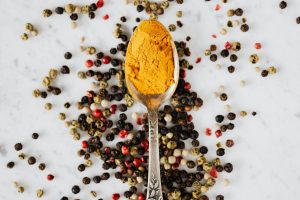
• Contain Hydroxycitric Acid
• Control Appetite
• Reduce Abdominal Fat Accumulation
• Booster Metabolism

• Contain Chlorogenic Acid and Caffeine
• Boost Fat Metabolism
• Control Appetite
• Lower Cholesterol and Triglycerides Levels
© 2025 Lyvv Science, Inc. All Rights Reserved.
Cart
No products in the cart.

